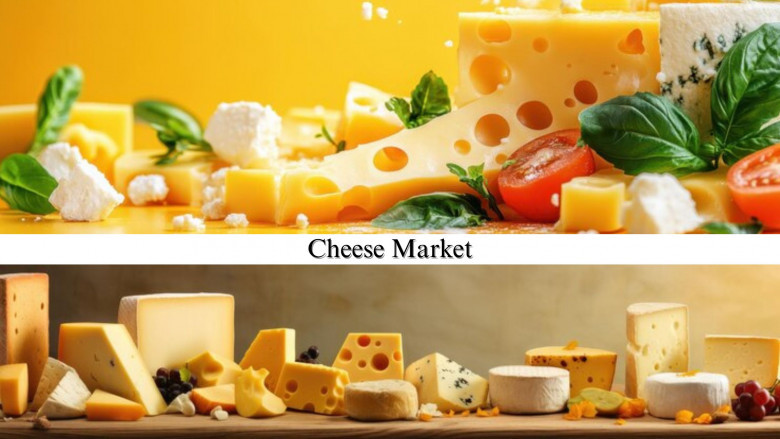views
The global cheese market was valued at USD 191.94 billion in 2024 and is forecast to grow from USD 199.14 billion in 2025 to USD 283.10 billion by 2032, recording a compound annual growth rate (CAGR) of 5.15% during the projection period. Europe remained the market leader in 2023 with a share of 49.13%. Meanwhile, the U.S. cheese market is set for notable growth, with an expected valuation of USD 62.66 billion by 2032, supported by the high demand for cheese in popular fast foods like pizza and sandwiches.
The widespread appeal of cheese stems from its versatility and broad range of varieties. The rising global popularity of ethnic cuisines, such as Italian and Mexican—which prominently feature cheese—continues to boost market demand.
According to data from the United States Department of Agriculture (USDA), per capita cheese consumption in the U.S. reached 40.2 pounds in 2020, up slightly from the previous year. Cheddar and mozzarella remain the most popular varieties among consumers.
Information Source: https://www.fortunebusinessinsights.com/cheese-market-104293
Market Segmentation
Extended Shelf Life and Growing Demand for Natural Cheese Fueling Market Growth
The market is segmented into natural and processed cheese. Artisanal producers are driving interest in natural cheeses by enhancing flavor and texture with herbs, spices, fruits, and nuts. At the same time, processed cheese maintains strong market penetration, especially in emerging markets such as South America, Asia Pacific, and the Middle East & Africa.
Animal-Based Cheese Continues to Lead, Though Plant-Based Options Are Gaining Ground
Based on source, the market is categorized into animal-based and plant-based cheese. Although plant-based alternatives—made from cashew, soy, almond, and other ingredients—are becoming more popular, animal-based cheese (produced from cattle, goat, sheep, and camel milk) still commands the largest market share. The extended shelf life and appealing packaging of animal-based cheese contribute to its dominance, although consumer interest in plant-based diets continues to grow.
Mozzarella Driving Market Growth
By product type, the market includes mozzarella, cheddar, parmesan, feta, and other varieties. Mozzarella remains the most widely consumed, given its integral role in popular dishes such as pizza, pasta, risotto, and enchiladas.
Block Cheese Sees Increased Demand
In terms of form, the market is divided into block, spreadable, and others. Block cheese—available in both soft and hard textures—commands the largest share due to its nutritional value and longer aging process. Spreadable cheeses are also seeing strong growth due to their convenience for snacking, baking, and cooking.

Widening Distribution Channels Support Market Expansion
Cheese products are distributed through supermarkets/hypermarkets, specialty stores, online retailers, and convenience stores. Supermarkets/hypermarkets lead the segment, offering wide product ranges and often providing in-store tasting experiences.
Regional Insights
The report examines market trends across Europe, North America, Asia Pacific, South America, and the Middle East & Africa.
Report Coverage
This comprehensive report explores:
- Major drivers, restraints, opportunities, and challenges
- Regional market trends and growth prospects
- Key industry players and their strategies
- Recent product launches, partnerships, mergers, and acquisitions
Market Drivers and Restraints
Rising Demand for Plant-Based Cheese
The growing trend of plant-based diets and veganism is driving interest in plant-based cheese made from nuts, soy, and other plant sources. The launch of new products in this category is expected to accelerate market growth.
On the other hand, growing awareness of potential health risks associated with casein—a protein found in traditional cheese—could impact consumer demand. Casein can trigger allergic responses, including acne, headaches, and inflammation, which may limit market expansion.
Regional Trends
Europe Strengthens Market Position Through Investments and Partnerships
European consumers are increasingly prioritizing organic and non-GMO products, which continues to drive growth in the region's cheese market.
In North America, demand is supported by busy lifestyles and a growing appetite for convenient, nutritious foods. The evolving preferences of millennials—particularly their interest in snackable and indulgent cheese products—are also shaping market trends.
Competitive Landscape
Product Innovation Remains Key to Market Leadership
Leading market players are launching innovative products and expanding distribution networks to strengthen their competitive position.
Prominent Market Players:
- The Kraft Heinz Company (U.S.)
- Fonterra Co-operative Group Limited (New Zealand)
- Arla Foods amba (Germany)
- FrieslandCampina (Netherlands)
- Saputo Inc. (Canada)
- Lactalis Ingredients (France)
- Wensleydale Creamery (U.K.)
- Dairy Farmers of America, Inc. (U.S.)
- SAVENCIA SA (France)
- Norseland Ltd (Tine Group) (U.K.)
Get Sample PDF Brochure: https://www.fortunebusinessinsights.com/enquiry/request-sample-pdf/cheese-market-104293
Key Industry Development:
- September 2021: Lactalis Canada launched two new direct-to-consumer platforms, DairyMarketCulinary.ca and Cheeseworld.ca, aimed at expanding online access to cheese and dairy products.










